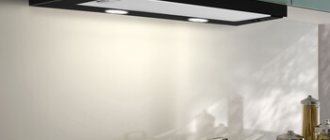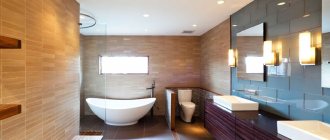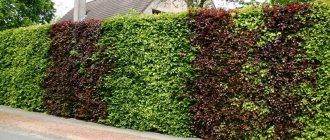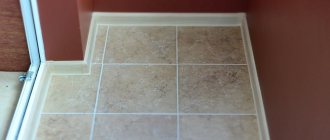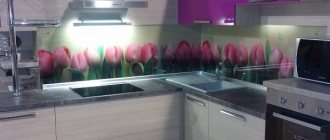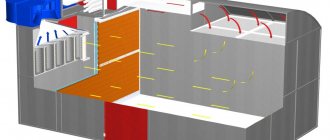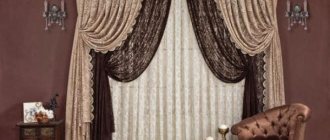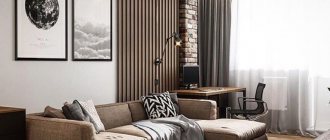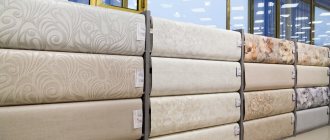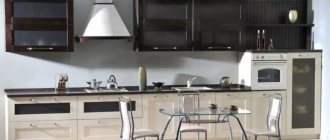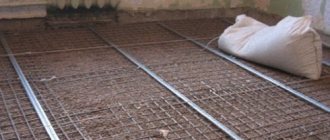Choosing a skirting board
When choosing a plinth, you need to pay attention to its color, texture and size. As a rule, the color of the plinth is matched to the tone of the floor or the tone of the wall
The most common option is to choose the color of the baseboard to match the color of the floor. Almost all major manufacturers of flooring have in their assortment a line of skirting boards that are best suited to a particular coating. If you don’t want to think long about choosing a skirting board, then just buy the one recommended by the manufacturer.
Skirting boards in the color of the floor
If the room has plain walls, then the best option would be to choose a baseboard that matches the tone of the walls; this will give the interior a holistic and complete look. However, if the walls in the room are covered with decorative plaster or wallpaper with a pattern, it is better to abandon this option.
White skirting boards are universal and suitable for almost any interior.
White skirting boards
Sometimes the color of the baseboard is matched to the color of the door, but this option is not suitable for every interior and it is better not to overuse it.
In rare cases, the color of the baseboard differs sharply from the color of the floor and walls and coincides with the main color accent of the room; as a rule, this is implemented in “designer” renovations, where a professional with extensive experience and well-developed taste is responsible for the choice of interior colors.
Stainless steel plinth
When choosing the size of the plinth, the rule is that the higher the ceilings of the room, the higher the profile of the plinth should be. With a ceiling height of about 3 m, it is advisable to use classic profile skirting boards with a height of 40 to 70 mm.
Skirting boards to match the color of furniture and door frames
If the room has high ceilings, then it is better to use a thin and high plinth in white or a contrasting color.
When choosing a plinth material, you need to proceed from your financial capabilities and type of flooring. Let's consider the possible material options in more detail.
Wide plinth for an apartment with a high ceiling
Metal baseboard for floor
These skirting boards are usually made of stainless steel, brass or aluminum. These materials have increased strength and are highly resistant to moisture, so rooms such as the bathroom, kitchen or hallway are often chosen for their installation.
Wide aluminum floor plinth
Metal floor skirting boards are also in demand in commercial buildings with heavy traffic. They are mounted on a base of commercial linoleum, tiles, porcelain stoneware and self-leveling floors.
Metal profiles differ:
- great strength;
- long service life;
- high resistance to mechanical loads, including impacts;
- are not afraid of moisture and extremely high and low temperatures;
- easy to install;
- There are models with a cable channel with the ability to build in sockets.
Metal floor framing
The main disadvantage of this type of skirting boards is the high price and limited choice of textures and colors.
How to choose the right plinth for the ceiling
Ceiling plinths come in a huge range; they can be concave or curved models, with relief patterns, with figured chamfers or smooth. What types of ceiling plinths are there:
Polystyrene foam is the most budget option, suitable for all types of ceilings, including suspended ceilings, but it turns yellow and shrinks with frequent changes in temperature and humidity.
Foam fillet - an inexpensive option for decorating the ceiling
Expanded polystyrene is the leader among all types of baguette, durable, lightweight, reliable, and bends slightly. Due to the density of the material, the relief pattern is clearly expressed. It can be glued to all types of ceilings; it is more often used for plasterboard structures; due to its rigidity, it is not recommended for use with tension systems.
Wide polystyrene baguette suitable for high roomsPolyurethane skirting boards - their price is higher than the previous 2 types, but this more than pays off in aesthetics and durability. Usually already finished, under a textured multi-colored film, or painted with patina and other techniques. The kit includes decorative corner segments and connecting strips.
Finished polyurethane skirting boards - interior decoration
Wooden fillets are rarely used, usually under a coffered ceiling or with a classic interior.
Wooden radius plinth for cladding columns
PVC borders are a special fillet with grooves for finishing with plastic panels.
Convenient and lightweight specialized PVC profile
Plaster stucco, which is used for certain interior styles. Heavy and brittle fillet, used with plasterboard or plastered ceilings.
Installation of gypsum stucco requires skills and knowledge of technology
Special soft, hidden skirting boards for suspended ceilings with decorative strips.
A huge color palette allows you to choose a fillet for any stretch ceiling, including those with a pattern
Installation instructions for plastic skirting boards
To install a plastic skirting board yourself, you need to prepare the following tools and materials:
- miter box;
- Bulgarian;
- hacksaw;
- drill;
- roulette;
- dowels
Installation of plastic skirting boards can be done using special fasteners. It should be noted that this method has both certain advantages and characteristic disadvantages. The category of advantages includes the possibility of easy dismantling of the plastic skirting board if necessary, as well as its re-installation. The disadvantage is that when re-installed, gaps may appear between the wall and the baseboard. When installing a plinth using this method, places for fastenings are marked on the wall and holes are drilled, the depth of each of which is 2-3 cm. The fastenings are fixed in the wall using plastic dowels. The distance between two adjacent holes should be 30-50 cm. Thanks to the special fastening design, the plastic plinth is “snapped” to it. Installation begins from one of the internal corners. In this case, the first fastening should be located no further than 10 cm from the corner. To join corner skirting boards without a gap, cut them using a hacksaw and a miter box. Another option that has become quite widespread is the installation of plastic skirting boards using liquid nails or special glue. During the implementation of this method, the necessary trimming of the baseboard is performed and its subsequent assembly around the perimeter of the room using an adhesive composition. The advantage of this method is the absence of the need for drilling and other dirty work; the disadvantage is the inability to reuse the dismantled plinth. Sometimes a plastic baseboard is attached to the wall using self-tapping screws. A plastic plinth mounted in this way does not look very attractive in comparison with the methods described above, but it is quite securely fixed in the place intended for this purpose. When implementing this method, the baseboard is trimmed in accordance with the dimensions of the perimeter of the room. Next, holes with a diameter of 2-3 mm are drilled in each of the plinths, in increments of 40-50 cm. In the holes, a larger diameter drill is used to make a conical recess for the screw head. To prevent the hole from being through, such a recess is best done manually.
Installation of the plinth begins from one of the inner corners. The prepared plinth is applied to the wall and the places where holes for the dowels should be drilled are marked with a pencil. Using an impact drill or hammer drill, drill holes in the wall, insert dowels into them, apply a plinth and fix its position using self-tapping screws. The screws must be tightened carefully, without excessive force, so as not to deform the plastic baseboard. The screw caps are hidden under special plastic plugs of the corresponding color. Regardless of which of the three described options is chosen, we should not forget that preliminary cutting of the plinth before installation should be carried out taking into account the own dimensions of additional fittings - end caps, as well as external and internal corners.
Design features
In the still unforgotten Soviet construction past, the plinth, as a rule, was made of wood, and its entire installation was a banal nailing. Today, fiberboard, SDF and, of course, the plastic we are discussing are used to make skirting profiles. But this does not mean that only professionals know the answer to the question of how to properly install a plastic skirting board. People without special construction skills can easily cope with this.
Today there are three types of plastic skirting boards on the market:
- for carpet and linoleum;
- universal;
- flexible.
The first one has an L-shape and with its lower part presses the finishing coating to the base. The groove made in the upper part is used to fasten the edge of the carpet, which is placed on the wall. Fastening is done using dowels. Visually, the perimeter frame does not differ from the main material, which makes this option elegant and modern.
The skirting board for carpet has a special groove into which the edge of the soft covering is inserted
Universal skirting boards have a hollow structure and, in turn, are divided into products with internal and external cable ducts. The advantage of both is the presence of special grooves into which a variety of power and signal cables can be laid. Models with internal cavities are attached to the wall using special brackets, which professional installers call clamps.
The plinth, which is attached to clips, has a simple design and an affordable price
Skirting boards of the second type have a channel on the outside, which, after installing the conductors, is closed with a special plug in the form of a long strip. Thanks to it, the fastening of models with an external cable channel can be done both using clamps and ordinary dowels - subsequently the fastening points will be hidden by the same flexible plug.
Models with an external cable channel are the most functional and convenient type of plastic floor skirting boardsExpert opinion Victor Kaploukhiy Thanks to my varied hobbies, I write on various topics, but my favorite ones are engineering, technology and construction.
The advantage of universal plastic skirting boards is that they can be removed and reused - you probably know about this from advertising videos of building materials manufacturers. But they are silent about the fact that even the most careful dismantling leads to damage to the plastic protrusion on the back of the finishing panel. This happens for the reason that the clamps have steel spikes curved inwards, which securely hold the product during operation. When exposed to force, cracks and peeling of the plastic appear in the fastening area, due to which it will not be possible to securely fasten the element to its old place. There is only one way out of this situation - move the clamp a couple of centimeters to the side so that it engages with the undamaged part of the baseboard. After this, the connection will again be reliable and durable.
The flexible plinth is designed for framing various curved surfaces - fireplace areas, wall curves, etc. Its installation is carried out using special glue. The disadvantage of such a frame is its one-time use. Typically, when dismantled, the product is damaged and cannot be reused.
Using a flexible plinth, you can design mills with the most intricate configurations
Performance properties of white MDF or PVC skirting boards
The uniqueness of the decorative element is as follows:
- no need for surface treatment;
- perfectly retains the original color and shape;
- ease of installation;
- in addition to white, the material can take on any shade, even simulating natural wood or stone;
- not afraid of temperature changes.
Floor skirting boards can have a different surface - flat, stepped or with convex decorative elements
Which white plinth to buy (MDF or PVC): types and sizes
Since its production, wide floor decor has become one of the top ten market leaders in just a few years. The material owes its popularity to a number of functional characteristics:
- high floor white plinth - effective protection of walls from mechanical damage and moisture;
- an economical way to quickly hide minor defects remaining after laying the floor covering;
- the presence of a cable channel from the inside helps to skillfully hide the wiring.
The height of decorative strips can reach 100 mm. The white plastic plinth (high) allows you to place any furniture almost close to the walls of the room.
White high floor plinth MDF or PVC is selected based on the height of the ceilings. For standard 2.7 m, a strip of 70 mm is suitable. In houses with three-meter parameters, the size of the plank is desirable within the range of 70-90 mm. For higher ceilings, you should consider purchasing a border over 100 mm.
A wide floor plinth will help disguise wall unevenness and hide small errors
The length of the plinth reaches 2500 mm, the maximum width is 25 mm, the height is up to 150 mm. Borders are often supplied in the form of long rolls: from 25 to 50 mm, which appear to the buyer in the form of a flexible tape. In most cases, they are laid along the entire perimeter thanks to seamless technology. The joints between the elements are closed with corresponding decorative corners.
Rules for installing white MDF or PVC floor plinths
Methods for installing borders have already been indicated; now it is worth considering the important nuances of the process itself. Before you buy a white baseboard for the floor, it doesn’t hurt to clarify all the installation details.
Manufacturers produce special fittings for plastic and finely dispersed fraction (MDF) borders:
- side plugs;
- connecting elements for 2 rails;
- corners (internal and external).
MDF plinth can be attached to the wall using clips or screws or glue
The above parts are not included in the package. They are purchased additionally; you must first calculate their required quantity. The border at the joints, in plugs, corners is inserted to a maximum of 5 mm. Therefore, it is recommended to cut the corners of this decor flush with the wall.
To install a border using dowel screws, you will need a hacksaw, a hammer drill for concrete and stone, a screwdriver, a pencil and a tape measure.
It is important to check the tone of each batten before installation. Even in the same package, the shades of the product may vary
To minimize the difference, it is better to mount darker colors opposite the light source.
When installing using dowel screws, corresponding holes are drilled in the curb every 300, maximum 500 mm. The profile with cable channel is covered with a special decorative strip.
Having decided to use clips for installation, it is important to secure them to the wall with dowel screws. The mount is placed around the perimeter of the room every 400, maximum 500 mm
In order for the profile to be easily fastened, the clips must be on the same line. This type of installation is only suitable if there are smooth walls. In a solid baseboard, the gap is hidden with a corresponding plug to match the material.
Installation of plastic plinth with adhesive sealant
When during installation there is not enough length of the slats, the cut can be made at an angle of 45 degrees. Then its upper part tends upward, in the opposite direction from the door.
How to choose a floor plinth: tips and tricks
This neat element protects walls from splashes during wet cleaning, prevents dust and dirt from collecting, hides wires and protects them from damage.
Radius plinth
When choosing a plinth, you need to take into account several factors, the main one being the size of the room. You can find out the parameter from the housing documents or take your own measurements with a tape measure. From the data obtained, subtract the width of the door and the space allocated for the heating radiator, add 1.5 - 2 meters and round up to a larger value. The number is divided by 2.5 (the length of one bar) and the number of required elements is obtained.
Skirting board with thread
The height of the material is selected taking into account the size of the room and the height of the ceilings. The higher these values, the higher the element should be. A high floor plinth looks appropriate in spacious rooms; for small rooms it is better to choose low options. Compact attributes will be lost against the background of the grandeur of the home, the comfort and coherence of the composition will disappear. A wide floor plinth will help hide the cracks, but will become an obstacle to placing furniture close to the walls.
Wide white plinth
Pro Tips:
- When purchasing, you need to carefully review the products, compare the batch numbers and colors;
- when choosing wide floor plastic materials, you should take care of the presence of such additions as plugs, corners and connecting parts;
- each element included in the kit must have a corresponding shade;
- Be sure to check the connection of the plank and additional elements: the composition should look harmonious, without unnecessary holes.
Wide baseboard
The shade of the material can match the color of the floor covering and serve as a neat finishing detail of the interior. Also, the element is selected to match the doors or a middle solution is chosen between the color of the floor and walls. The white floor plinth looks stylish and unobtrusive; the beige version adds calm chords. Light-colored materials add extra square footage to a room, but they also require careful and regular maintenance. Among shades of black, wenge color is popular. The rich tone looks stylish and impressive.
Veneered plinth
Installation of plastic skirting boards
Depending on the type of product and the type of flooring, the methods of installation differ. But in any case, installing skirting boards with your own hands will not be difficult.
Installation using clips
This method of installing a plinth with or without a cable channel involves fastening the supporting strip using special clips. Then a shaped strip is hung on the bar.
How to install:
- Attach clips to the wall every 50 cm using dowel nails.
- Place the baseboard strip on the clips.
This hidden method allows you to get a solid plank without any traces of screws.
Self-tapping installation
Fastening with self-tapping screws ensures a tighter fit of the planks to the wall, even if it is not very level.
Sequencing:
- Mark the fastening points. Having retreated 5–7 cm from the corner of the wall, make the first mark, then continue in increments of 30–40 cm.
- Using a hammer drill, drill holes according to the marks made.
- Hammer the dowels into the holes.
- Place the plank against the wall and, in the marked places where there are already dowels, carefully pierce it with an awl.
- Insert a self-tapping screw into the hole and place it on the dowel.
- Connect the next plank to the previous one using connecting elements.
- Having reached the corner, saw off the excess piece of the plank and close it with a corner.
- Pull the necessary wires and cables into the cable channel.
- Cover with an external decorative profile.
Installation with glue
Attaching skirting boards with glue yourself is easy and not labor-intensive. But this installation has an important drawback: when dismantling the glued plastic strips, their appearance inevitably deteriorates. Therefore, this method is suitable for you if you plan not to disturb the installed baseboards for a long time.
How to stick:
- put a corner on one end of the plastic baseboard strip;
- coat the inside with glue;
- place the plinth against the wall and press it;
- put on the connecting element;
- do this with all the planks.
The most popular way to attach plastic skirting boards with your own hands is to install them using self-tapping screws. Still, the choice is yours
It is only important to correctly correlate all the parameters and not miss the details
Plastic floor plinth
PVC skirting boards are the most popular today. Plastic floor plinth has exceptionally high consumer qualities and, first of all, amazing ease of installation and versatility.
Wide plastic floor skirting boards: a combination of aesthetics and functionality
Thanks to the latest technology, the plastic used in the production of these products is quite durable. It is resistant to mechanical stress, but at the same time elastic. A plastic floor plinth is in no way inferior to its wooden counterpart, and in some characteristics even surpasses it. Plastic panels are moisture resistant, extremely easy to maintain, and do not require significant financial investments or time. One cannot fail to mention its biological stability - it does not rot, does not corrode, and does not create an environment favorable for the life of bacteria.
Original version of the heating system: heated baseboard
Plastic floor skirting boards are easy to cut and shape, so they are simply irreplaceable when framing round or multi-profile walls.
If you want to give the PVC product some shape, just heat it with a hairdryer or hot water to about 70°C.
Moldings for floor plinths made of plastic
All kinds of plastic elements for edging corners, external and internal, help to avoid inaccuracies when filing corners when joining. On their reverse side there are special clip-on grips: the corners are placed on the edge of the bar and snapped into place.
The use of corners when connecting plastic fillets significantly improves the aesthetics of the finish
Plastic floor plinth: dimensions, shape and color scheme
The height of the plastic floor profile varies between 5 cm and 8–10 cm. The most popular products are 60 mm high; they cover approximately 22 mm along the floor, providing a large gap. The standard profile length is 2.5 m, although there are samples up to 5.05 m.
Soft PVC roll profile
Plastic floor skirting boards are also supplied in the form of rolls 25–50 m long. They are a flexible tape that is laid using almost seamless technology along the entire perimeter. True, it is almost devoid of decorative properties, so its main purpose is to finish the joints of floors and walls in offices and administrative premises.
How is flexible floor plinth used?
PVC profiles have a wide range of colors, both plain and textured - “wood”, “metal” and more. For example, you can choose the color and texture of the panel to match any natural wood: oak, mahogany, wenge, etc. This provides enormous design opportunities for decorating a room.
Spectacular white high plinth for the floor adds special elegance to the interior
The shape of the edging has also become more elegant: it can be flat or convex, with a “leg” or protrusion.
Increasingly, in the design of modern large rooms you can find wide floor plinths made of plastic. Combined with high ceilings, it gives majesty to the structure.
Plastic panels are used with almost any coating: laminate, porcelain stoneware, ceramic tiles, carpet, linoleum, self-leveling and wood floors.
However, when finishing floors made of artistic parquet or solid boards, you should first think about whether the simpler look of PVC skirting boards will be dissonant with their luxurious appearance.
Plastic panels, despite their flexibility, are still inferior to wooden ones. The reason is the hollow structure of polyvinyl chloride, so it is better to handle the installed plastic floor profile more carefully.
Floor plinth with cable channel
Today, wide skirting boards for floors with cable ducts are in great demand. What are their advantages?
Floor plinth with cable channel
- Inside the product you can hide up to ten cables laid along the walls;
- they allow electrical wiring to be carried out without undesirable difficulties, while maintaining the appearance of the room unchanged;
- The presence of a removable panel on the outside of the profile allows you to complete the existing cable system
A similar design, although much less common, is still found in wooden versions.
The undoubted advantage of these products is the soft rubber edge, which allows you to effectively hide uneven walls and floors.
When choosing the dimensions of products with a cable channel, proceed from the number of wires that are supposed to be routed through it. On the one hand, I would like to have a compact model, but on the other hand, wouldn’t it be better to install a floor plinth of greater thickness in order to be able to lay another cable if necessary.
Skirting board with cable duct made of plastic: sizes are selected depending on the number of wires
Polyurethane floor plinth
Wide profiles made of foamed plastic – polyurethane – are no less in demand. This material has many positive characteristics. For example, we can note its strength and environmental friendliness, lightness and moisture resistance.
A high polyurethane plinth divides the wall horizontally, visually expanding the space
Polyurethane floor plinths are available in two versions:
- already painted and ready for installation;
- white, ready for painting.
Invalid Displayed Gallery
Choosing the height of the plinth
The height of the floor plinth should be harmoniously combined with the height of the walls (ceilings) and the upper fillet. In rooms where the ceilings are located at a distance of about 2.5 meters from the floor, it is better to make skirting boards 3-5 cm, 2.7 meters from the floor - 6-7 cm. The final choice depends on the style, color of the walls and floor, area. For medium-sized rooms with calm, classic interiors, it is permissible to increase the height by 2-3 times without compromising their appearance. To play with space, use the rule: elements that are close in lightness and saturation to the shade of the walls do not make the high ceiling smaller; those that are contrasting or the same color as the floor expand the space, but make the ceilings a little lower.
White floor plinth made of PVC or MDF: which is better?
Before buying a white plinth, it is important to determine your priority material. PVC skirting boards are suitable for floors made of tiles, linoleum or laminate
In the production of such a decorative element, extrusion of polyvinyl chloride is used. The film or coloring of the material is responsible for the variety of color solutions.
PVC skirting boards are ideal for use in wet areas - bathrooms and kitchens
The material for the production of MDF appears as a result of exposure to vacuum and pressing of wood fibers. No resins are used in its production. The outside is treated with a paint coating or protected with melamine decorative paper. The plinth is environmentally friendly. The cost of the two listed materials (PVC and MDF) will be low.
There is a third type of floor decor - MDF plinth covered with PVC film on top. Having chosen one of three material options, many opt for white. The latter is universal and matches almost any color scheme indoors. If earlier, when choosing such elements, we relied on the shade of the floor covering, but now white contrasts perfectly with dark wood and emphasizes the beauty of the chosen style.
MDF skirting boards are made in various shades, but white ones look more elegant in the interior
White MDF plinth: characteristics
Many people want to buy a white floor plinth for a reason: MDF is a more environmentally friendly material than chipboard. It contains no phenol or resins. Paper soaked in dyes is glued to the front layer of the material. This solution protects the top coating from possible peeling over time.
The melamine coating on the above paper is responsible for protecting the decorative element from persistent stains of dirt, ultraviolet radiation, moisture and dust. White floor plinth (wide or thin) favorably emphasizes the strengths of the interior. The material is easy to clean and inexpensive. The only drawback is excessive fragility.
You can buy MDF plinth in white or any other shade: from light to imitating natural wood or stone. Often, to achieve originality in a room, contrasting tones are used. In some cases, white doors and white baseboards are considered ideal.
MDF plinth may have a built-in channel for laying wires inside
The floor decor is attached to the wall in any of the following ways:
- The use of liquid nails and glue is important if the planks do not have a fastening channel. Having carefully adjusted the size of the plinth and made an accurate calculation of the parameters, the glue is applied to the plane of the plinth.
- Self-tapping screws are used together with dowels for greater adhesion density. The method involves drilling a small hole in the wall for the dowel, into which a self-tapping screw is screwed.
- Clips, fastening strips, latches are a lightweight installation method. Assumes the presence of fastening channels on the back side of the baseboard.
White plastic skirting board: material structure
PVC skirting boards are also considered one of the leaders for beautifully decorating the floor and hiding technological gaps during repairs. The production process of polyvinyl chloride is divided into several types.
Semi-rigid – white floor skirting boards are produced under high pressure conditions. The modified structure of the material acquires flexibility, suitable for laying on a curved surface without the need to form cracks.
Plastic plinth can have one of three levels of rigidity
Hard plastic floor plinth (white or any other color) is the most common type of decor. Traditionally laid on straight areas. The rotating parts are connected by certain corners.
The foamed type has high thermal insulation, which serves as additional insulation for the floor covering.
White PVC plinth is selected in accordance with the geometry of the walls, room parameters and other additional factors. Installation of this decor is simplified as much as possible thanks to the composite design: the decorative panel is on the outside, the mounting film is on the inside.
How to attach a plinth to the floor? It can be summarized that there are three methods of fastening, namely:
- For a self-tapping screw.
- On glue.
- On clips.
White baseboard looks beautiful in combination with flooring of a darker shade
Wooden plinth
Today, wood products are the most popular; they are presented in a wide price range and are well suited to various design solutions. Wooden floor skirting boards include veneered and solid elements. When producing the first option, coniferous wood is taken as a basis, which is covered with a thin layer of veneer; the second option is a part of natural wood. The presented products are distinguished by long-term operation, attractive appearance and the ability to restore their original condition. Wooden skirting boards can have different sizes and are environmentally friendly.
Curly plinth
Skirting board with wall fastenings
Advantages of veneered skirting boards:
- acceptable price;
- ease of installation;
- safety and naturalness.
The use of veneer skirting boards can often be seen in apartments and houses, thanks to the large selection of shades and high-quality imitation of natural wood. Today you can choose a color that is close to natural, artificially aged or bleached.
A curved plinth will help to beautifully complement the column in the interior, and the wenge shade in a duet with a beige floor will add a stylish contrast to the room.
The disadvantage of this option is that coniferous wood requires precise adherence to the temperature and humidity values in the room.
Skirting board with hole for cables and wires
Stone plinth
For adherents of natural materials, MDF floor plinth would be a good option. In the manufacture of elements, wood fibers are used, which are combined into one composition using a press and high temperatures. The visible surface is covered with laminate or veneer.
Varnished plinth
MDF panels with plinth
Advantages of wood fiber products:
- resistance to moisture and direct sunlight;
- easy to wash and clean;
- inexpensive;
- The material is presented in a wide range of colors.
Tile plinth
This plinth goes well with laminate flooring. You can choose a baseboard that matches the floor or is a little darker. The wenge option gives the room a special character and looks decent against the background of light walls and black doors. The white MDF attribute visually enlarges the room and saturates the atmosphere with light notes. The disadvantage of the selected plinth is that it has a low level of strength compared to wooden products. The maximum size of elements is 60 mm.
Skirting for painting
Overview of methods for fixing skirting boards
Liquid Nails
The simplest, most efficient, but irrational method from the point of view of subsequent alterations is the use of a “liquid nails” binder composition. True, for installing fragile veneered plinths, this is one of the rational methods. The whole technology includes two processes: treated with glue from the back, fixed on the floor or wall.
Attaching skirting boards with “liquid nails” is a method “for centuries”
Clips and straps for fixation
A plinth made of MDF or plastic with internal devices for fixing to a supporting strip or a clip, does not have holes for screws on the surface. The hidden installation method involves attaching only a supporting element to the base, onto which slats are then hung.
To install the internal part of the structure:
- place the first fastening element on the floor 5 cm from the corner from which installation will be carried out clockwise, press the clip tightly against the wall, mark through the hole a place for drilling holes for dowels;
- in increments of 50 cm, holes are marked and then drilled in the wall, the diameter of the drill determines the size of the dowels supplied with the slats;
- using the included fasteners, the devices of the hidden fastening system are mounted;
Skirting boards on clips - convenient and practical
The final installation of skirting boards on clips or strips is done by simply pressing.
Installation method with dowels and screws
Installation begins with markings. The starting point is a corner the length of the wall. Before marking, the plastic plinth is equipped with a corner accessory. The edge of the wooden slats is sawn off at an angle of 45º.
- To mark the position of the first point, you need to step back 5 or 6 cm from the corner.
- The baseboard must be pressed tightly against both mating surfaces. Next, a hole is drilled through the designated first point so that a mark from the drill remains on the wall. Thin walls of plastic skirting boards can be pierced with a simple awl to apply markings.
- The rail is moved away from the wall.
- Holes are formed in the walls or floor using a hammer drill for subsequent driving of dowels into them.
- Then the dowels are mounted, the plinth is applied according to the markings, and self-tapping screws are inserted and screwed into the holes on top of the slats attached to the wall.
Fastening with dowels and screws - marking features
After fastening, the heads of the screws and defects are masked with primer and a wax pencil.
The subsequent steps are similar to the beginning. After installing the elements along the entire perimeter, the screw heads can be masked with a wax pencil, matched to the color of the baseboard. The defects resulting from sawing off wooden planks can be hidden with a primer.
Traditional wooden baseboard for flooring
The classic version, a wooden floor plinth, has not lost its relevance today, with the only difference being that it has turned from a household floor frame into an elite one. To characterize a modern, high-quality wood product, you will have to use epithets such as luxurious or sophisticated.
Oak plinth: dovetail profile
The following models of wooden skirting boards are especially popular:
- profile with a “sole” - has a height of up to 60 mm, a distinctive feature is a relatively narrow lower part, up to 25 mm. The smoothed topography of the front side of the product makes it easier to remove dust;
- europlinth - its dimensions are 10-16 mm, allowing you to install furniture quite tightly to the wall. There are other, non-standard models of products, for example, up to 80 mm high with a figured recess on the front part or up to 30 cm, made of beech or oak.
The perfection of a wooden plinth: wide fillets in a dark color
